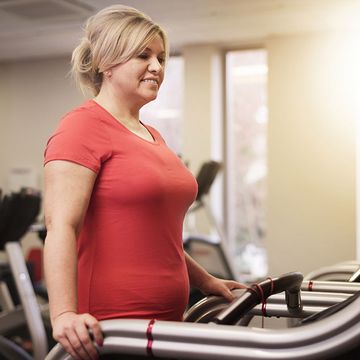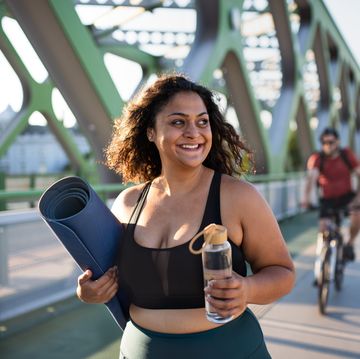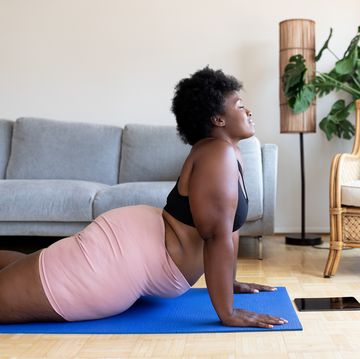When I was in my 20s, I’d go to the gym, hop on a machine and start working out without thinking twice about my joints. Now, at 55, there are days when it seems a whole lot easier to skip my workout altogether than to deal with my achy knees. And, since you’re reading this, I’m guessing you can relate to my frustration.
The key, as I’m sure you probably know: Getting ourselves to do it anyway. Research shows that regular exercise helps to reduce the chronic inflammation associated with arthritis and can even increase your pain tolerance. Exercise also strengthens the muscles around the joint and increases blood flow to the joint, two things that can minimize discomfort, says Nathan Wei, MD, a rheumatologist in Frederick, MD. It also increases the production of endorphins, which can further reduce pain (not to mention put you in a better frame of mind to handle it).
If you’re thinking, "Seriously? Have you been in my body lately?? It hurts!" I hear you. Getting started when your body sounds and feels like the Tin Man is far from easy. But making a few simple changes to your exercise routine can mean the difference between a pain-free workout and one that hurts.
Here are 11 tweaks and tricks that can make staying active when you're hurting so much easier.
1. Warm up thoroughly.

Media Platforms Design Team
Most people tend to skip the warm-up, but there’s good reason for you not to: Jumping into a workout without first warming up your muscles can increase joint pain, especially after age 40, says David Kruse, MD, a board certified sports medicine specialist with Hoag Orthopedic Institute in Irvine, CA. "Joints hurt more when muscles and tendons are stiff. As we age, our joint mobility and tissue flexibility decline; a thorough warm-up helps accommodate these changes." It doesn’t have to be long and it doesn’t have to complicated: Five minutes of light movement, like an easy walk, is all you need to get that blood flowing, warm up your muscles, and get them ready for the task at hand.
2. Use a foam roller.
Joint pain can feel worse when your fascia (the elastic, weblike matrix of fibrous connective tissue that supports, binds, or separates your other tissues, joints, and organs), becomes dry and brittle—something that happens as we age. Ideally, your fascia acts a cushion for your joints, and helps to protect them from impact during exercise, says Sue Hitzmann, an exercise physiologist and creator of The Melt Method. The more hydrated your fascia, the more cushion you get. Creating gentle compression with a soft foam roller helps rehydrate your fascia by stimulating its cells and helping fluid move back into that tissue, says Hitzmann. While research shows that foam rolling before or after your workout can minimize discomfort, Hitzmann says that even doing it three times a week can reduce joint pain by about half. Get started with these
4 foam rolling exercises.
3. Shake things up.
If you want to avoid overuse injuries—not to mention burnout and boredom—you know it’s not a great idea to do the same routine every single day. But mixing up your workouts is even more important if you have achy joints or arthritis, says Kruse. Muscles are involved in the control and function of joints; when they’re weak from overuse, your joint is forced to take on more impact. (So if you’re pushing through a run with overworked quads, for instance, you’re likely to feel it in your knees.) Instead, mix up high-impact activities, like running, with something a little more gentle—think swimming, biking, yoga, or Pilates—once or twice a week.
4. Find the best cardio for you.
To determine the best cardio program for your joints, Kruse recommends testing various progressions of impact to find your tolerance level. Start with the least impactful movement and slowly increase until you find your breaking point (that moment when your joints start to complain). For example, you may be able to use a recumbent bike without pain, but upgrading to an upright bike could cause issues. "How much you can do depends on the source of the pain and discomfort," says Kruse. "You may feel soreness while you’re doing the activity or the next day—keep a log to track how you react to each exercise plan to find what’s most effective." According to Kruse, the activities ranked by the least to most impact are swimming, recumbent bike, upright bike, elliptical, treadmill, outdoor running.
5. Alternate upper and lower body exercises.

Media Platforms Design Team
The usual workout advice is to work your bigger muscles first and then move on to the smaller ones, mainly because the smaller muscles stabilize and support the larger ones. But bouncing back and forth between upper and lower body exercises makes life easier for your joints by giving them a longer break in between. When weight training, for example, alternate between arm and leg exercises to avoid overworking one body part or joint within your exercise routine, says Christa Gurka, MSPT, a physical therapist and founder of Pilates in the Grove in Miami, FL.
6. Take time to stretch.
When time is of the essence (and when isn’t it?) it’s tempting to skip stretching post-workout to save time—but your joints will pay the price. "Tight muscles decrease normal movement patterns and range of motion within joints," says Gurka. "For example, tight quadriceps will push more heavily on the kneecap and cause more inflammation to an already compromised joint." So after your workout, be sure to stretch out all of your major muscle groups, holding each stretch (do not bounce) for 20 to 30 seconds. (Try these
3 essential stretches after your next walk.)
7. Use props to ease pain.
Planks and push-ups can be hard enough without dealing with sore wrists. Luckily, almost any exercise can be modified to make it more comfortable. "Take pressure off wrists when doing planks by performing them while on your forearms instead," says Gurka. For push-ups, try using dumbbells or yoga blocks to hold on to, which keep your wrists straight, as opposed to having your hands on the floor. Or, as an alternative to push-ups, try using a Smith machine (a bench press type machine on a sled) or use a higher body angle, says Irv Rubenstein, PhD, exercise physiologist and owner of S.T.E.P.S., a science-based fitness facility in Nashville, TN. "Exercise tubing or cable machines may also work."
8. Shift your weight.
If your knees complain when you do squats or lunges, there’s an easy fix to turn down the discomfort: Shift your weight back on to your heels, versus the balls of your feet, which reduces strain on the kneecaps and quadriceps, says Gurka, making the moves more comfortable. How can you tell if you’re doing it correctly? When your weight is in your heels, you should be able to wiggle your toes off the floor. As a bonus, you’ll also firm up your backside faster, as keeping the weight in your heels activates your glutes. (If squats are out of the question for you, give this
no-squats belly, butt, and thighs workout a try.)
9. Modify your range of motion.

Media Platforms Design Team
In addition to shifting your weight, shortening your range of motion can also ease joint pain. This works on both upper and lower body exercises such as chest presses, as well as squats and lunges. "Do not allow your knees to bend below 90 degrees, as this increases compressive forces on the joint surfaces," says Gurka. To reduce the risk of shoulder pain, avoid overhead movements such as overhead presses, and strengthen shoulders by keeping your palms up during moves such as lateral raises. This opens up the shoulder joint and allows for more space and less likelihood of shoulder impingement, i.e., when the shoulder blade puts pressure on the rotator cuff muscle, causing pain, says Gurka.
10. Include yoga or Pilates.
Consider these low-impact modalities your joints' new best friends. "Pilates, for example, focuses on joint mobility and stability, creating balance around joints and increasing flexibility around joints," says Gurka. "It also works on body awareness to improve balance and alignment." Additionally, yoga has been shown to work particularly well for those with
rheumatoid arthritis; a study by the Arthritis Foundation found that two, one-hour yoga classes eased pain and swelling for those with
rheumatoid arthritis. (
Here’s a gentle yoga practice to get you started.)
11. Add water.
Even if you don’t know the backstroke from the butterfly, working out in a pool can be a game-changer. "The buoyancy of the water results in less body weight on the joint, so any movements that you do takes less impact," says Rubenstein. The deeper the water, the more support and the less impact on joints. An added bonus: water provides resistance so you can still build and strengthen the muscles that surround and support joints. Overhead movements like the crawl stroke can create a greater risk of pain for those with shoulder arthritis, so stick with the breaststroke if your shoulders ache, says Rubenstein. Also give
our joint-friendly water workout a try.

Linda Melone is a certified trainer and a health and fitness writer. In addition to Prevention, she writes regularly for Health, Livestrong, Shape, NextAvenue and many others. She lives in California but pines for her New York roots. Follow her on Twitter: @LindaMelone or visit her at www.LindaMelone.com.













